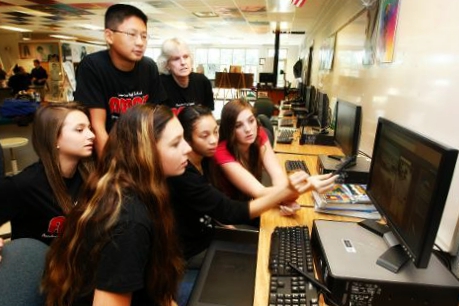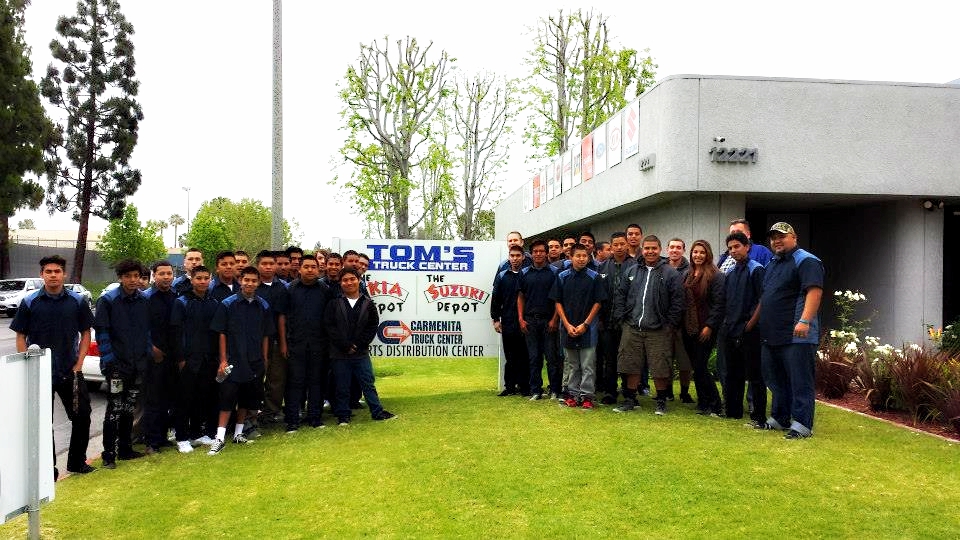Rudy Villalobos was just a couple weeks into an internship at an Audi service department when he offered a suggestion to some veteran technicians performing an alignment.
What if, he asked, the team clicked on an alternate computer screen that displayed more information, including a detailed list of the tools needed?
The techs didn’t know such a screen existed.
“They were shocked,” says Rudy, 19. “They wanted to know where I learned that.”
It turns out he learned that and a lot more at High School Inc., a program that operates on the campus of Valley School High in Santa Ana.
High School Inc. was established through a partnership between the Santa Ana Unified School District, the Santa Ana Chamber of Commerce and the High School Inc. Foundation, and it recently raised a few eyebrows when it announced that students who entered the program as sophomores had posted a near-perfect graduation rate of 98.5 percent in 2014. (To add context, Orange County’s overall graduation rate was 88.6 percent last year, and the rate for California was about 81 percent.)
But graduation numbers only tell part of the story. What’s perhaps most unique is this school-within-a-school’s approach to blending college and career readiness.
 At High School Inc., students enroll in one of six specialized academies that integrate career technical education with traditional classroom subjects such as English, math, social studies and science.
At High School Inc., students enroll in one of six specialized academies that integrate career technical education with traditional classroom subjects such as English, math, social studies and science.
The academies were strategically designed to meet 21st-century workforce needs. They include Culinary Arts and Hospitality, Healthcare, Automotive Logistics and Transportation, New Media, Global Business and Engineering, and Manufacturing and Construction.
Rudy graduated from the automotive academy, taking with him four college credits. Now he’s enrolled at Santa Ana College — and employed at the Audi dealership.
“Ever since I was small, I always liked working on cars,” he says. “Having the courses in school made me like it even more. I was hands-on every day.”
Donnie Crevier, the CEO of High School Inc., is also a car guy. Until 2011, he ran Crevier BMW, the family business. He says the concept of High School Inc. was brainstormed almost a decade ago by Chamber of Commerce leaders who were looking for strategies to strengthen the local workforce. They reached out to Mr. Crevier, who had some thoughts.
“We had a huge need for automotive technicians,” he says, “and we still do.”
But what began as a strategy for bolstering vocational training evolved into a hybrid of college and career readiness, leveraging local businesses to help prepare students for the modern workplace.
“We found that for kids who get into these career tech programs, all of a sudden the critical thinking aspect of their education comes alive,” Crevier says. “They start thinking about education long-term and broad-term. It opens their eyes to working toward a goal.”
“Some of them will go on to college and pursue other things,” he says, “and some will stay on their chosen career paths.”
High School Inc. officially launched at Valley in 2007, and the program has continued to grow. Last year, about half of Valley’s 2,200 students participated in one of the six academies, which were open to sophomores, juniors and seniors. This year, freshmen can also enroll.
“High School Inc. academies provide Valley students with small learning communities where students connect in a cohort of like-minded students and a smaller number of teachers that provide the core and (career tech) curriculum,” says Valley Principal David Richey.
“It’s my belief that students who commit to a High School Inc. academy are very well positioned when they graduate high school to have multiple opportunities, and they are certainly college and career ready,” Richey says. “I’m not sure you can find that type of preparation in most high schools.”
Mark McLoughlin, president of the High School Inc. Foundation board, says teachers from each of the academies work closely with business advisors to help students pursue their interests, discover their talents and develop post-graduation plans.
Students get to hear from guest speakers and take field trips to colleges, universities and businesses. Training luncheons, networking, competitions and awards ceremonies also help bring the curriculum to life.
 Academies can reach capacity, so enrollees are asked to select their first, second and third choices during registration. Meanwhile, there are also opportunities for interaction among the academies, McLoughlin says.
Academies can reach capacity, so enrollees are asked to select their first, second and third choices during registration. Meanwhile, there are also opportunities for interaction among the academies, McLoughlin says.
For example, automotive students might team up with their engineering counterparts on a project that asks them to design a fuel-efficient car capable of racing long distances. Culinary students might be asked to prepare meals for classmates on a field trip.
“We believe we have hit the momentum that we wanted to be on with this project,” McLoughlin says. “Now we’re trying to fine tune some of our processes and procedures and scale this up.”
Indeed, the partners behind High School Inc. would like to see the model take root at other schools and perhaps other districts. And it’s worth noting that its objectives align nicely with a new county initiative called OC Pathways.
Led by the Orange County Department of Education and Saddleback College, OC Pathways was created last year to expand career pathways for students across all academic levels. The project is backed by a $15 million grant from the California Department of Education and now boasts the involvement of more than a dozen school districts, nine community colleges, two major universities, four regional occupational programs, three workforce investment boards, numerous community partners and 100-plus businesses.
Speaking of businesses, Mark Bartholio is the coordinator of High School Inc.’s Global Business Academy, which holds a special state designation as a California Partnership Academy.
Bartholio says each year area business leaders guide his students through the process of setting up fictitious companies, and some invite the aspiring entrepreneurs to tour their corporate headquarters.
These kinds of real-world experiences build soft skills and give high schoolers a chance to apply what they’ve learned in the classroom, he says. They also connect the students with a world they’ll interact with soon enough.
“They look forward to the day when the business partners are going to come,” Bartholio says. “They dress for success, and they’re eager to report on the progress they’ve made for their projects.”
